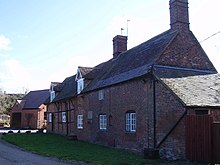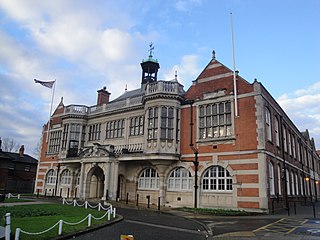
Hendon is an urban area in the London Borough of Barnet, northwest London 7 miles (11 km) northwest of Charing Cross. Hendon was an ancient manor and parish in the county of Middlesex and a former borough, the Municipal Borough of Hendon; it has been part of Greater London since 1965. Hendon falls almost entirely within the NW4 postcode, while the West Hendon part falls in NW9. Colindale to the northwest was once considered part of Hendon but is today separated by the M1 motorway.
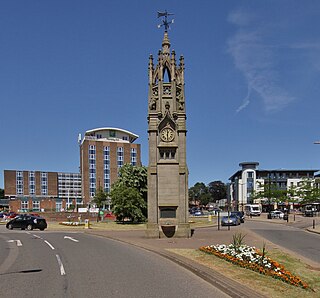
Kenilworth is a market town and civil parish in the Warwick District in Warwickshire, England, 6 miles (10 km) south-west of Coventry and 5 miles (8 km) north of Warwick. The town lies on Finham Brook, a tributary of the River Sowe, which joins the River Avon 2 miles (3 km) north-east of the town. At the 2021 Census, the population was 22,538. The town is home to the ruins of Kenilworth Castle and Kenilworth Abbey.

Warwick is a market town, civil parish and the county town of Warwickshire in the Warwick District in England, adjacent to the River Avon. It is 9 miles (14 km) south of Coventry, and 19 miles (31 km) south-east of Birmingham. It is adjoined with Leamington Spa and Whitnash.

British Leyland was a British automotive engineering and manufacturing conglomerate formed in 1968 as British Leyland Motor Corporation Ltd (BLMC), following the merger of Leyland Motors and British Motor Holdings. It was partly nationalised in 1975, when the UK government created a holding company called British Leyland, later renamed BL in 1978. It incorporated much of the British-owned motor vehicle industry, which in 1968 had a 40% share of the UK car market, with its history going back to 1895. Despite containing profitable marques such as Jaguar, Rover, and Land Rover, as well as the best-selling Mini, BLMC had a troubled history, leading to its eventual collapse in 1975 and subsequent part-nationalisation.

The Triumph Motor Company was a British car and motor manufacturing company in the 19th and 20th centuries. The marque had its origins in 1885 when Siegfried Bettmann of Nuremberg formed S. Bettmann & Co. and started importing bicycles from Europe and selling them under his own trade name in London. The trade name became "Triumph" the following year, and in 1887 Bettmann was joined by a partner, Moritz Schulte, also from Germany. In 1889, the businessmen started producing their own bicycles in Coventry, England.

Ryton-on-Dunsmore is a village and civil parish in the Borough of Rugby, Warwickshire, England. It is situated 6 miles southeast of Coventry and 8 miles west of Rugby. The 2001 Census recorded a population of 1,672 in the parish, increasing to 1,813 at the 2011 Census. The A45 dual carriageway bissects Ryton, and nearby villages include Bubbenhall, Stretton-on-Dunsmore and Wolston. Garden Organic, the leading organic growing charity in the United Kingdom, has a 10-acre (4-hectare) demonstration garden dedicated to organic gardening in the village. Ryton Pools Country Park is about a mile south-west of the village.
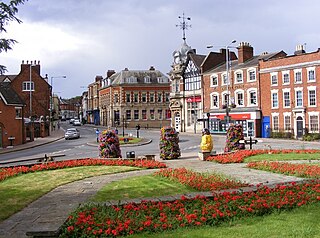
Sutton Coldfield or the Royal Town of Sutton Coldfield ( ), is a town and civil parish in the city of Birmingham, West Midlands, England. The town lies around 8 miles northeast of Birmingham city centre, 9 miles south of Lichfield, 7 miles southwest of Tamworth, and 7 miles east of Walsall.

The Standard Motor Company Limited was a motor vehicle manufacturer, founded in Coventry, England, in 1903 by Reginald Walter Maudslay. For many years, it manufactured Ferguson TE20 tractors powered by its Vanguard engine. All Standard's tractor assets were sold to Massey Ferguson in 1959. Standard purchased Triumph in 1945 and in 1959 officially changed its name to Standard-Triumph International and began to put the Triumph brand name on all its products. A new subsidiary took the name The Standard Motor Company Limited and took over the manufacture of the group's products.

Meriden is a village and civil parish in the Metropolitan Borough of Solihull, West Midlands, England. Historically, it is part of Warwickshire and lies between the cities of Birmingham and Coventry. It is located close to the North Warwickshire district border within a green belt of the countryside known as the Meriden Gap and is in the ecclesiastical parish of the Diocese of Coventry.
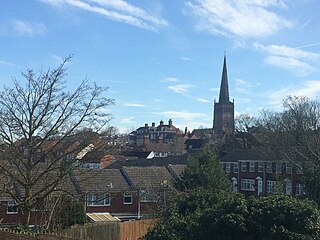
Coleshill is a market town and civil parish in the North Warwickshire district of Warwickshire, England, taking its name from the River Cole, on which it stands. It had a population of 6,900 in the 2021 Census, and is situated 11 miles (18 km) east of Birmingham, 8.5 miles (13.7 km) southeast of Sutton Coldfield, 11 miles (18 km) south of Tamworth, 13 miles (21 km) northwest of Coventry by road and 13 miles (21km) west of Nuneaton. It borders the parish village of Kingshurst in the Metropolitan Borough of Solihull to the west. It is also home to the 502 year The Coleshill School seated next to the dual carriageway.

Coventry, a city in the West Midlands, England, grew to become one of the most important cities in England during the Middle Ages due to its booming cloth and textiles trade. The city was noted for its part in the English Civil War, and later became an important industrial city during the 19th and 20th centuries, becoming the centre of the British bicycle and later motor industry. The devastating Blitz in 1940 destroyed much of the city centre, and saw its rebuilding during the 1950s and 60s. The motor industry slumped during the 1970s and 80s, and Coventry saw high unemployment. However, in the new millennium the city, along with many others saw significant urban renaissance and in 2017 it was announced that the city had been awarded the title of 2021 UK City of Culture.

Small Heath is an inner-city area in south-east Birmingham, West Midlands, England situated on and around the Coventry Road about 2 miles (3 km) from the city centre.

Cheylesmore is a suburb in the southern half of the city of Coventry, West Midlands, England. It is one of Coventry's largest suburbs, sharing borders with Whitley and Stivichall in the South, extending into Coventry city centre and bordering with Earlsdon in the North. Locally pronounced as 'Charlesmore' or occasionally 'Chellsmore', Cheylesmore has two shopping parades situated in Daventry Road and Quinton Park. These shops overlook a small park and pool known as Quinton Pool. It takes its name from Cheylesmore Manor. The original name probably derives from 'Chez Les Morts' since a huge plague pit was found during excavations after the Second World War. The city gate leading to the area was labelled as Childsmore Gate on old maps, an alternative etymology of the name.

Canley Vale is a suburb of Sydney, in the state of New South Wales, Australia. Canley Vale is located 30 kilometres west of the Sydney central business district, in the local government area of the City of Fairfield and is part of the South Western Sydney region.
Canley Heights is a suburb of Sydney, in the state of New South Wales, Australia 31 kilometres west of the Sydney central business district, in the local government area of the City of Fairfield and is part of the South-western Sydney region.

Cannon Park is a suburb in the south-west of the City of Coventry, West Midlands, England. It can be accessed via the major roads Kenpas Highway (A45) or Kenilworth Road. The area has a sizable shopping centre of the same name which features food stores, shops and eateries. Tenants include a post office, Tesco and Iceland.

Westwood Heath is a southwestern suburb of the City of Coventry in the West Midlands, England.

Canley railway station is situated in Canley, Coventry, in the West Midlands of England. The station, and all trains serving it, are operated by West Midlands Railway.

Hay Mills is an area of east Birmingham, England straddling the A45 Coventry Road about 3 miles (5 km) south east of the city centre. North of the Coventry Road is mainly residential whereas the south is mixed residential and commercial. The area was subsumed into Birmingham in 1911.

Tile Hill is a suburb in the west of Coventry, West Midlands, England. It is mostly residential and partly industrial, with some common land and wooded areas. Tile Hill railway station is located on the West Coast Main Line which links Coventry with London and Birmingham, and is situated at the southwestern border with the city's Canley district and the Metropolitan Borough of Solihull.

